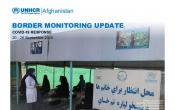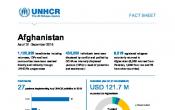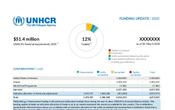Afghanistan
Operation: Afghanistan
Location
{"longitude":65,"latitude":34,"zoom_level":0,"iso_codes":"'AFG'"}
By clicking on the icons on the map, additional information is displayed.
The boundaries and names shown and the designations used on this map do not imply official endorsement or acceptance by the United Nations.
Key Figures
| 2019 year-end results | |
| 500,000 | individuals benefitted from UNHCR’s investments in education, health care, WASH and other community infrastructure projects in the PARRs |
| 68,800 | people were reached through UNHCR’s protection monitoring |
| 13,900 | youth benefited from multi-sector livelihoods support and market-based skills training |
| 8,200 | people with specific needs were assessed, of whom 6,900 were assisted directly with cash and in-kind services, while 500 more were referred to other agencies for specialized services. An additional 29,500 people were assisted indirectly through the persons with specific needs (PSN) programme |
| 8,000 | Afghan refugees voluntarily repatriated with the assistance of UNHCR, including 6,100 from Pakistan, 1,900 from the Islamic Republic of Iran, and 80 from other countries |
| 2,140 | households received tents and 50,650 households received core relief items and sanitary kits from UNHCR and cluster partners |
| 2020 planning figures | |
| 60,000 | internally displaced Afghan households will receive core relief items |
| 500 | refugees and asylum-seekers with specific needs will receive sectoral cash grants |
| 60 | educational facilities will be constructed or improved |
Latest Updates
Updates and additional information are available on UNHCR's Inter-Agency Information Sharing Portal.
People of Concern
12%
Increase in
2019
2019
| 2019 | 3,081,364 |
| 2018 | 2,759,010 |
| 2017 | 2,454,451 |

[["Refugees",72228],["Asylum-seekers",251],["IDPs",2553390],["Returned refugees",8402],["Others of concern",447093]]
Loading ...
Afghanistan
< Back
2019
{"categories":[2015,2016,2017,2018,2019,2020],"budget":[150.64388638999998,259.233864759,137.62688892399999,125.83413416,121.70568010000001,123.20575754],"expenditure":[70.35477096,197.82190746,70.00669812999999,62.05985309999999,60.63418638,null]}
{"categories":[2015,2016,2017,2018,2019,2020],"p1":[66.83857404999999,187.89448891,79.923683844,35.933201600000004,29.176983649999997,23.22182739],"p2":[null,null,null,null,null,null],"p3":[56.925098549999994,42.006523619,39.774421090000004,60.243961299999995,71.18420028,73.11959682999999],"p4":[26.88021379,29.33285223,17.92878399,29.656971260000002,21.344496170000003,26.86433332]}
{"categories":[2015,2016,2017,2018,2019,2020],"p1":[42.224187969999996,174.62465414,42.60149276,16.78422529,11.994052589999999,null],"p2":[null,null,null,null,null,null],"p3":[17.783146690000002,12.48364936,10.39492624,23.78516525,30.24308225,null],"p4":[10.3474363,10.71360396,17.01027913,21.490462559999997,18.39705154,null]}
Loading ...
CHOOSE A YEAR
- 2014
- 2015
- 2016
- 2017
- 2018
- 2019
- 2020
Operational context
As the protracted Afghan refugee situation entered its fifth decade, Afghans remained the second largest refugee population in the world.The operational environment remained challenging due to intensifying conflict and political uncertainty, which also caused high levels of internal displacement. Attacks on humanitarian workers resulted in constraints on UNHCR’s ability to provide certain services.
UNHCR continued to play a catalytic role in channeling humanitarian and development investments into the priority areas of return and reintegration (PARRs), identified jointly with the Government of Afghanistan. The PARRs link community-based protection projects to longer-term development programs and encourage private sector investment, at the same time benefitting returnees, IDPs and host communities. They are aligned with Afghanistan’s national peace and development framework and national priority programmes, notably the Citizens’ Charter, as well as the Displacement and Return Executive Committee (DiREC) policy framework and action plan on returnees and IDPs.
Population trends
UNHCR’s planning for 2019 anticipated the return of 60,000 Afghan refugees from neighbouring countries; however, due to political uncertainty and ongoing conflicts, the number was significantly lower. In all, some 8,100 Afghan refugees returned from the Islamic Republics of Iran and Pakistan and other countries with UNHCR’s assistance and were processed at encashment centres in Afghanistan, a 49% decrease in comparison to 2018.Conflict continued to impact all provinces in Afghanistan, with some 460,000 individuals internally displaced by conflict in 2019. At the same time, drought and other natural disasters drove additional displacement.
Achievements
- Shelter was an urgent priority for IDPs, returnees, refugees and host communities. The operation rolled out a pilot cash-for-shelter project, assisting 600 vulnerable households to construct permanent shelter through the provision of conditional cash assistance of approximately $3,300 per household.
- UNHCR also provided nearly 900 refugee housing units (RHUs) to Afghanistan as a temporary solution to address the major gaps in community infrastructure. By the end of 2019, over 700 RHUs had been installed across the country, with over 80% being used as temporary classrooms. The RHUs were also used as health clinics, community centres and transit centres.
Unmet needs
While the volatile security situation and political uncertainty played a role in the decision of refugees not to return, return monitoring indicated that Afghanistan’s limited absorption capacity also impacted people's decisions. Lack of livelihoods, land, shelter, and limited access to basic services were highlighted by refugees and returnees as primary obstacles to return.Funding shortages required that UNHCR focus on the most crucial needs among the wider gaps existing in PARR locations. As a result, the situation in many return areas remained challenging. The target population remained at risk of resorting to negative coping mechanisms. In many locations, UNHCR was the only agency providing much needed access to basic services, livelihoods for youth, land, and shelter assistance to vulnerable returnees, IDPs and members of the host community.
Operational Environment
While Afghanistan is entering the 40th year of protracted displacement, UNHCR expects the humanitarian situation to remain complex, despite the encouraging efforts in peace negotiations and the strong political will in Afghanistan. Persistent socio-economic challenges compound protection risks and limit returnee reintegration prospects, which often results in negative coping mechanisms, such as child labour, early marriage, labour exploitation and debt.Under the Solutions Strategy for Afghan Refugees (SSAR) framework, the Government of Afghanistan will continue progress on development and sustainable reintegration through the implementation of the Displacement and Return Executive Committee (DiREC) policy framework and Action Plan, while challenges will likely persist in fully translating policy into implementation at the field level.
In July 2018, the Government of Afghanistan officially announced its decision to join and support the Comprehensive Refugee Response Framework (CRRF) as a country of origin. Going forward, UNHCR and partners will work closely with the Government of Afghanistan to develop a roadmap and decide upon the way forward in rolling out comprehensive responses in this specific context.
The planned Parliamentary and Presidential elections in Afghanistan during October 2018 and early 2019, respectively, may result in demonstrations and targeted attacks on election related premises, thus impacting UNHCR’s operations.
The Ministerial Conference on Afghanistan that will take place in Geneva in November 2018, co-hosted by Afghanistan and the United Nations, will demonstrate progress made towards benchmarks set at the 2016 Brussels Conference and should also reinvigorate donor support for continued resources and engagement.
In 2019, UNHCR’s planning assumptions are based on the expected returns of some 60,000 refugees to Afghanistan. However, returns may increase or decrease depending on the protection environment in Afghanistan and in the region.
Highly complex scenarios of internal displacement, marred by insecurity and shrinking humanitarian space are expected to continue in 2019. Drought will create protection risks for IDPs, increasing their vulnerability and reliance on negative coping mechanisms.
Key Priorities
In 2018, UNHCR will focus on:- Supporting voluntary repatriation to Afghanistan. Upon return to Afghanistan, each Afghan refugee returnee is given USD 200 in one of the four encashment centers in Herat, Jalalabad, Kabul or Kandahar. This cash grant will cover transportation costs from the country of asylum to the place of origin and will partially assist returnees in managing their immediate humanitarian needs upon return. Cross-border referrals, enhance protection monitoring through UNHCR filed visits, and inter-agency joint assessments will enable the identification of people with specific needs and facilitate a timely response and referral within established network of service providers.
- Informed by protection monitoring, with limited resources, UNHCR will continue to exercise its responsibilities as the Protection Cluster lead, coordinating protection activities in humanitarian settings, and as Emergency Shelter Cluster lead in conflict situations, coordinating and directly intervening in the delivery of in-kind relief items or cash-based humanitarian assistance to conflict-induced IDPs.
- Scaling down its interventions for displaced families from Pakistan’s North Waziristan Agency and responsibly hand over the management of response to the Government of Afghanistan.






















